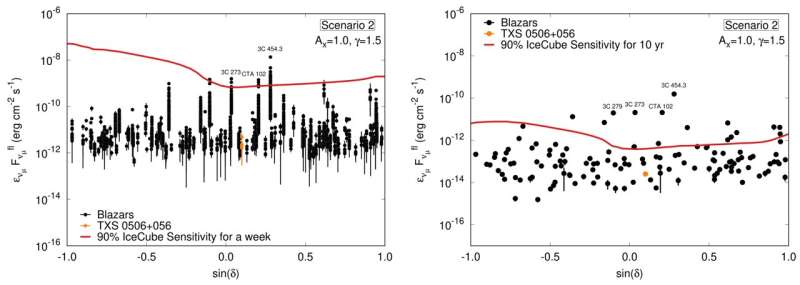This article has been reviewed according to Science X's editorial process and policies. Editors have highlighted the following attributes while ensuring the content's credibility:
fact-checked
peer-reviewed publication
proofread
Investigating the contribution of gamma-ray blazar flares to neutrino flux

Blazars belong to the family of active galactic nuclei called quasars. What differentiates them from quasars is that the flares ejected out of these active galactic nuclei are pointed toward the Earth. These flares contain high-energy cosmic rays which are released from the core of these galaxies as jets spanning many light years. Such cosmic rays can interact with photons to produce subatomic particles called neutrinos.
Gamma-ray flares from blazars are thought to be the primary events behind neutrino detection in the sky. In 2017, the South Pole neutrino detector "IceCube" detected a high-energy neutrino event whose timings and positioning in the night sky coincided with the flare of a blazar called TXS 0506+056. Some scientists suggest that there could be a population of blazars whose flares are accompanied by high-energy neutrino emission. However, the relationship between blazar flaring activity and neutrino flux is yet to be properly understood.
In this regard, an international research team, led by Professor Kenji Yoshida from the Department of Electronic Information Systems at Shibaura Institute of Technology, Japan, has recently performed a comprehensive statistical analysis to understand the contribution of gamma-ray flares to neutrino emission.
The team included Maria Petropoulou from the National and Kapodistrian University of Athens, Kohta Murase from The Pennsylvania State University, and Foteini Oikonomou from the Norwegian University of Science and Technology. Their paper was published in The Astrophysical Journal.
The researchers analyzed 145 blazars, 144 taken from the Fermi Large Area Telescope Monitored Source List and including TXS 0506+056, in this study. They first calculated a weekly average of the gamma-ray flux of the blazars and plotted their light curves. The team then derived the flare duty cycle (fraction of time spent in a flaring state) and the corresponding energy fraction from these curves using a Bayesian blocks algorithm, a statistical method used to identify changes in a time series.
"We find that blazars with lower flare duty cycles and energy fractions are more numerous among our sample. Their flare duty cycles and energy fractions represent power law-like distributions, correlating strongly with each other. We found a significant difference between blazar subclasses for the flare duty cycles at the 5% significant level," says Prof. Yoshida, highlighting the major results of their analysis.
The researchers evaluated the neutrino energy flux of each gamma-ray flare, using a general scaling relation for the neutrino and gamma-ray luminosities with a power law's weighting exponent of 1.0–2.0, normalized to the quiescent gamma-ray or X-ray flux of each blazar. They also found that the gamma-ray flare distribution indicates that blazar neutrino emission may be dominated by flares for the weighting exponent >1.5.
Furthermore, by comparing their neutrino predictions for each blazar for one-week and 10-year periods to the time-integrated IceCube sensitivity, the team placed upper limits on the contributions of the flares to the isotropic diffuse neutrino flux.
Prof. Yoshida remarks, "We hope that this study helps improve our understanding of the contribution of blazars to astrophysical neutrinos. Application of the present method to further observations might have the potential to contribute to the advancement of scientific knowledge of the origin of astrophysical neutrinos."
More information: Kenji Yoshida et al, Flare Duty Cycle of Gamma-Ray Blazars and Implications for High-energy Neutrino Emission, The Astrophysical Journal (2023). DOI: 10.3847/1538-4357/acea74
Journal information: Astrophysical Journal
Provided by Shibaura Institute of Technology




















